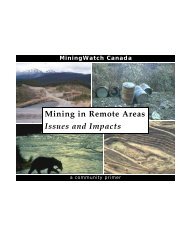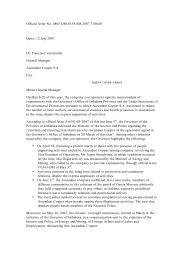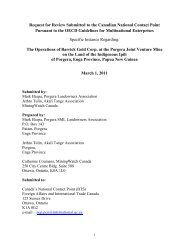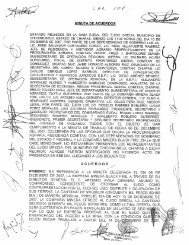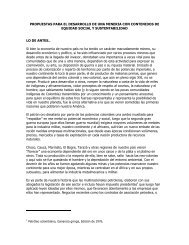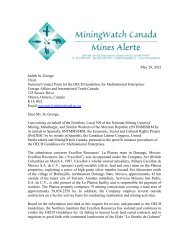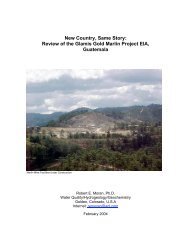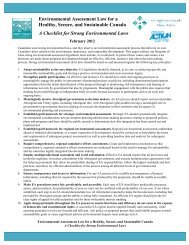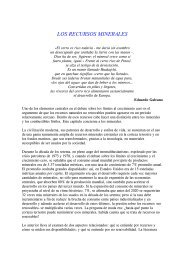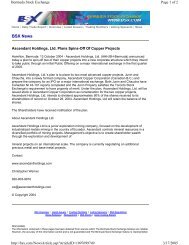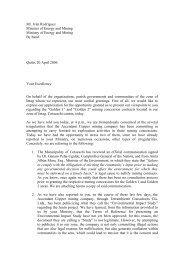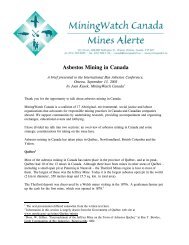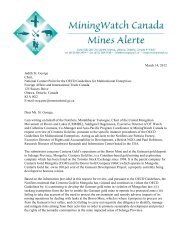Environmental Aspects of Phosphate and Potash Mining
Environmental Aspects of Phosphate and Potash Mining
Environmental Aspects of Phosphate and Potash Mining
- No tags were found...
You also want an ePaper? Increase the reach of your titles
YUMPU automatically turns print PDFs into web optimized ePapers that Google loves.
<strong>Environmental</strong> <strong>Aspects</strong> <strong>of</strong> <strong>Phosphate</strong> <strong>and</strong> <strong>Potash</strong> <strong>Mining</strong>L<strong>and</strong> RentalThe phosphate rock orebody in Togo being extractedby the Office Togolais des <strong>Phosphate</strong>s (OTP) is locatednear the coast in an area <strong>of</strong> intensive small-scale farming.Surface mining methods are used to remove theoverburden <strong>and</strong> extract the phosphate rock ore. Thisrequires the progressive relocation <strong>of</strong> farmers <strong>and</strong> villagecommunities as mining occurs. In compensation,the company pays farmers a rental for the l<strong>and</strong> disturbedduring the mining process. New villages areconstructed in advance outside the mining area, to rehousedisplaced villagers. The l<strong>and</strong> rental continuesuntil rehabilitation is completed <strong>and</strong> the l<strong>and</strong> is onceagain suitable for farming.for providing compensation to avoid conflict.Solarevaporation ponds used to extract potash from surfacebrine deposits usually cover a wide area <strong>of</strong> l<strong>and</strong>,with operations in the region <strong>of</strong> 90 square kilometres.The precipitation <strong>and</strong> build up <strong>of</strong> salt in the pondsover time presents an issue.Water ConsumptionIn some locations, water consumption during extractionactivities may lead to a lowering <strong>of</strong> the surroundingwater table.Water inflow is a common problem where open pits<strong>and</strong> underground openings intersect aquifers.Generally, water is pumped from the excavations orfrom nearby wells to maintain a dry, safe <strong>and</strong> efficientoperating environment for the equipment. This maypotentially lead to the lowering <strong>of</strong> the surroundingwater table <strong>and</strong> the depletion <strong>of</strong> nearby surface waterbodies. In some locations, measures have been takento confine the area affected by water table depression<strong>and</strong> protect the surrounding ecosystem.Ecosystem Protection Through the Use <strong>of</strong>Perimeter DitchesThe elevated water table is a prominent feature <strong>of</strong> theFlorida ecosystem. Frequent surface appearance <strong>of</strong>the aquifer has produced a patchwork <strong>of</strong> wetl<strong>and</strong>s,streams, rivers <strong>and</strong> lakes.This presents an issue for theefficient extraction <strong>of</strong> the phosphate rock deposit bydraglines. If the opencast pit contains water, draglineoperators have difficulty identifying the boundarybetween the ore <strong>and</strong> overburden, potentially resultingin the loss <strong>of</strong> ore or dilution by barren rock. Tomaintain dry excavations <strong>and</strong> an efficient operatingenvironment, the water table may be depressed to alevel below the ore by pumping from wells or sumps.However, this may lead to negative effects on the surroundingwater-sensitive ecosystem. To overcomethis, companies such as IMC <strong>Phosphate</strong> <strong>and</strong> CargillFertilizers Inc have implemented protection systems,using a perimeter ditch to confine the impact on thewater table to the immediate mining area.Before pumping commences, a perimeter ditch isexcavated around the mining area to a depth belowthe water table. The ditch is filled with water that ismaintained at a level consistent with the originalwater table, using a series <strong>of</strong> weirs <strong>and</strong> pumps. Whenthe water table is depressed by mining activities,recharge occurs from water in the ditch.Performance <strong>of</strong> the system is monitored by both dailyvisual inspection <strong>of</strong> the ditches <strong>and</strong> by weekly measurements<strong>of</strong> the water table, through a series <strong>of</strong>piezometers located outside the perimeter ditch.The effectiveness <strong>of</strong> the method has been improvedby reshaping the overburden immediately adjacent tothe perimeter ditch as soon as possible on completion<strong>of</strong> mining. This allows the water table to partiallyreestablish itself inside the perimeter ditch.The application <strong>of</strong> this approach protects the surroundingwater-sensitive ecosystem by confining thedepression <strong>of</strong> the water table to the area delineatedby the ditch.Waste water produced during the extraction stage canbe used for downstream processing operations, reducingthe dem<strong>and</strong> on other sources. In some places,water <strong>of</strong> suitable quality has been used for the irrigation<strong>of</strong> local farming operations. This is <strong>of</strong> greaterimportance in arid climates where water resources arelimited.Water ContaminationExcavation activities may contaminate surface waterthrough the release <strong>of</strong> fines generated during clearing,blasting <strong>and</strong> excavation operations, the weathering <strong>of</strong>overburden contaminants susceptible to leaching <strong>and</strong>the release <strong>of</strong> salt from brines <strong>and</strong> potash ore.Perimeter ditch - IMC <strong>Phosphate</strong>, USA



